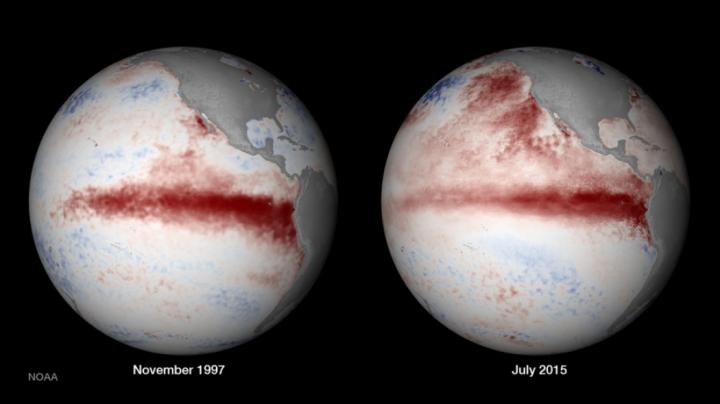The El Niño Southern Oscillation, swings of heating and cooling of equatorial Pacific waters, occur every two to seven years in spring, when the warm phase swells into a long heat blob in the tropical Pacific, typically peaking in early winter.
It blows through oceans and air around the world, ginning up deluges, winds, heat, or cold in unusual places.
Once El Niño passes, the cycle reverses into La Nina, when airstreams push hot water westward and dredge up frigid water in the equatorial Pacific. This triggers a different set of global weather extremes.
Tropical Pacific corals record the hot-cold oscillations by absorbing less of an oxygen isotope (O18) during El Niño's hot phases, and progressively more of it during El Niño's cool phases. As corals grow, they create layers of oxygen isotope records, chronicles of temperature history.
This data has been used to show that stronger El Niño's are part of a climate pattern that is new and strange.

The team compared temperature-dependent chemical deposits from present-day corals with those of older coral records representing relevant sea surface temperatures from the past 7,000 years. They identified patterns in the El Niño Southern Oscillation (ENSO) swings; industrial age El Niño swings were 25 percent stronger than in the pre-industrial records.
Corals' recordings of sea surface temperatures have been shown to be accurate when benchmarked. Coral records from 1981 to 2015 matched sea surface temperatures measured via satellite in the same period so exactly that, on a graph, the jagged lines of the coral record covered those of the satellite measurements, obscuring them from view. To confirm their findings they left out chunks to see if the industrial age ENSO signal still stuck out. They removed the record-setting 1997/1998 El Nino-La Nina and examined industrial age windows of time between 30 and 100 years long.
"What we're seeing in the last 50 years is outside any natural variability. It leaps off the baseline. Actually, we even see this for the entire period of the industrial age," said Kim Cobb, the study's principal investigator and professor in the Georgia Institute of Technology's School of Earth and Atmospheric Sciences. "There were three extremely strong El Nino-La Nina events in the 50-year period, but it wasn't just these events. The entire pattern stuck out."


